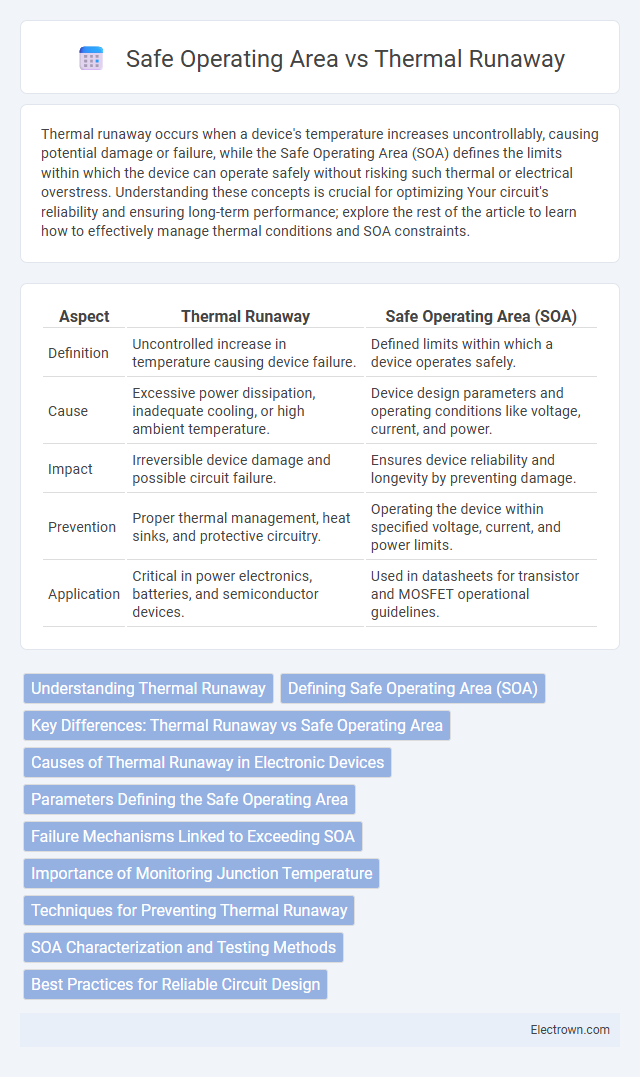Thermal runaway occurs when a device's temperature increases uncontrollably, causing potential damage or failure, while the Safe Operating Area (SOA) defines the limits within which the device can operate safely without risking such thermal or electrical overstress. Understanding these concepts is crucial for optimizing Your circuit's reliability and ensuring long-term performance; explore the rest of the article to learn how to effectively manage thermal conditions and SOA constraints.
Table of Comparison
| Aspect | Thermal Runaway | Safe Operating Area (SOA) |
|---|---|---|
| Definition | Uncontrolled increase in temperature causing device failure. | Defined limits within which a device operates safely. |
| Cause | Excessive power dissipation, inadequate cooling, or high ambient temperature. | Device design parameters and operating conditions like voltage, current, and power. |
| Impact | Irreversible device damage and possible circuit failure. | Ensures device reliability and longevity by preventing damage. |
| Prevention | Proper thermal management, heat sinks, and protective circuitry. | Operating the device within specified voltage, current, and power limits. |
| Application | Critical in power electronics, batteries, and semiconductor devices. | Used in datasheets for transistor and MOSFET operational guidelines. |
Understanding Thermal Runaway
Thermal runaway occurs when a device's temperature rises uncontrollably due to increasing current, causing further heating and potential device failure. Understanding thermal runaway is critical in designing circuits within the safe operating area (SOA), which defines the maximum limits of voltage, current, and temperature a device can handle without damage. Proper adherence to the SOA prevents thermal runaway by ensuring devices operate within their thermal and electrical boundaries.
Defining Safe Operating Area (SOA)
The Safe Operating Area (SOA) defines the boundaries of voltage, current, and power conditions within which a semiconductor device can operate without damage or failure. Understanding the SOA is crucial to prevent thermal runaway, which occurs when increased temperature leads to escalating current, surpassing device limits and causing irreversible damage. By adhering to the SOA specifications, you ensure reliable device performance and longevity while avoiding the risks associated with thermal instability.
Key Differences: Thermal Runaway vs Safe Operating Area
Thermal runaway refers to a self-reinforcing process where increasing temperature causes a device's current to rise uncontrollably, potentially leading to device failure. The Safe Operating Area (SOA) defines the voltage, current, and power limits within which a semiconductor device can operate reliably without damage. Unlike thermal runaway, which describes a hazardous thermal instability, SOA provides engineered boundaries to prevent such conditions and ensure device longevity.
Causes of Thermal Runaway in Electronic Devices
Thermal runaway in electronic devices occurs when increased temperature causes a rise in current, leading to further heating and potential device failure. Key causes include excessive power dissipation, improper heat sinking, and high ambient temperatures that exceed the safe operating area (SOA) limits of semiconductors. Devices operating outside their specified SOA risk irreversible damage due to uncontrolled temperature escalation and reduced electrical stability.
Parameters Defining the Safe Operating Area
The Safe Operating Area (SOA) of a semiconductor device is defined by critical parameters including maximum voltage, current, power dissipation, and junction temperature to prevent thermal runaway. Key limits such as avalanche energy, transient thermal resistance, and time duration govern the device's ability to handle fault conditions without failure. Maintaining operation within these boundaries ensures reliable performance and protects against destructive thermal events.
Failure Mechanisms Linked to Exceeding SOA
Exceeding the Safe Operating Area (SOA) causes thermal runaway by pushing semiconductor devices beyond their maximum rated voltage and current limits, leading to uncontrolled temperature rise and device destruction. Failure mechanisms such as junction overheating, secondary breakdown, and transistor latch-up occur due to excessive power dissipation and inadequate heat dissipation within the SOA boundaries. To protect your circuits, maintaining operation within the specified SOA prevents irreversible damage caused by thermal runaway and ensures device reliability and longevity.
Importance of Monitoring Junction Temperature
Monitoring junction temperature is critical in preventing thermal runaway, as excessive heat can rapidly degrade semiconductor devices leading to catastrophic failure. Adhering to the Safe Operating Area (SOA) ensures that devices operate within specified thermal and electrical limits, maintaining reliability and performance. Real-time temperature monitoring enables dynamic adjustments to prevent junction temperatures from exceeding safe thresholds, safeguarding component longevity and functionality.
Techniques for Preventing Thermal Runaway
Techniques for preventing thermal runaway include improving heat dissipation through advanced cooling systems and using thermal sensors to monitor temperature hotspots in real-time. Operating devices within their Safe Operating Area (SOA) ensures voltage, current, and temperature limits are not exceeded, preventing device failure due to excessive stress. Designing circuits with protective components such as current limiters and thermal shutdown features further safeguards your electronic components against thermal runaway.
SOA Characterization and Testing Methods
Safe Operating Area (SOA) characterization involves defining the voltage, current, and power limits within which a semiconductor device can operate without damage, ensuring reliable performance under varying electrical conditions. Testing methods for SOA typically include pulse testing, short-circuit testing, and thermal cycling to evaluate the device's ability to withstand transient events and prevent thermal runaway. By understanding SOA, you can design circuits that avoid exceeding these limits, protecting components from catastrophic failures due to overheating or excessive power dissipation.
Best Practices for Reliable Circuit Design
Thermal runaway occurs when a device's temperature rises uncontrollably, risking permanent damage, while Safe Operating Area (SOA) defines the limits within which a device can operate safely without degradation. Designers ensure reliable circuits by selecting components with adequate thermal margins and strictly adhering to SOA specifications to prevent excessive current and voltage stresses. Implementing effective heat sinking, thermal monitoring, and circuit protection mechanisms further mitigates thermal risks and enhances device longevity.
Thermal runaway vs Safe operating area Infographic

 electrown.com
electrown.com